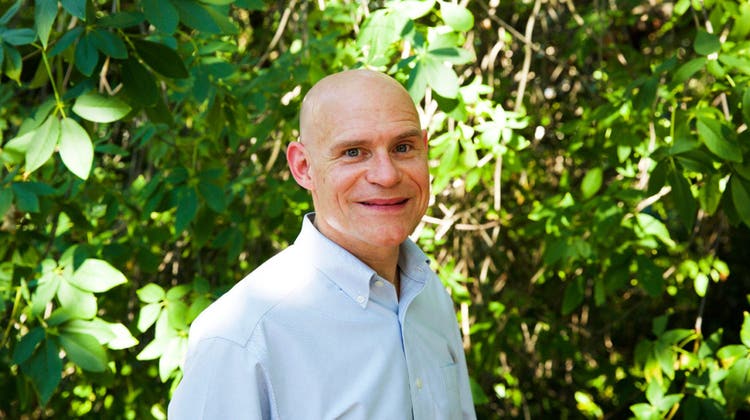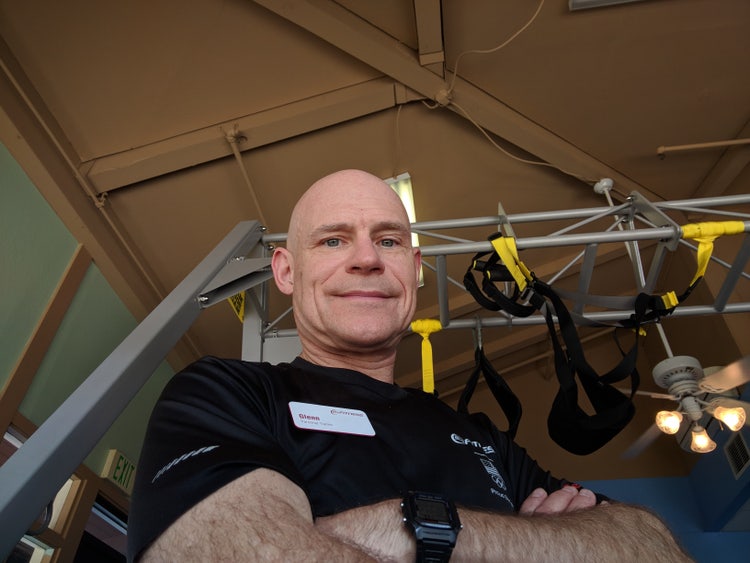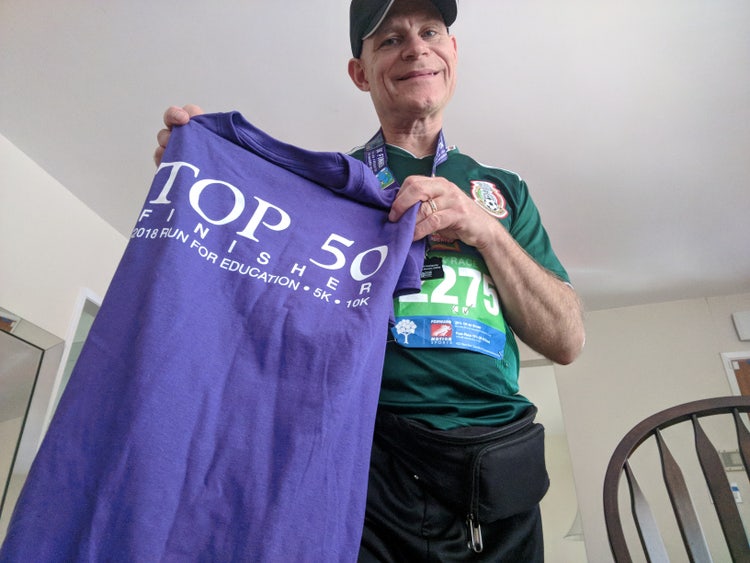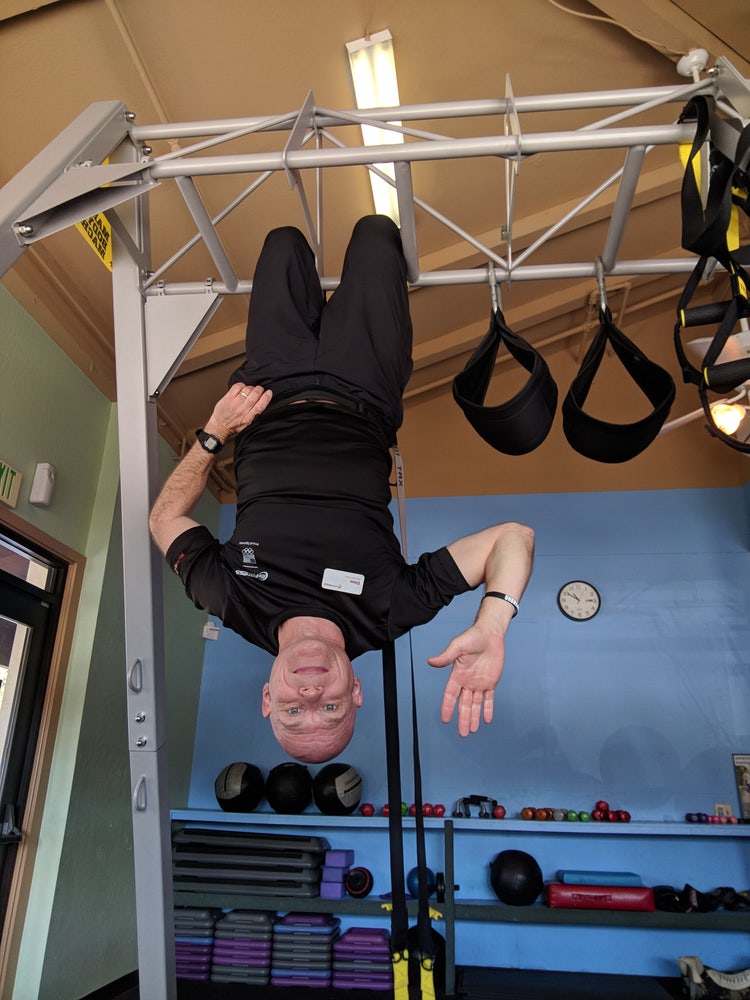How Glenn Anaiscourt Went From Lawyer to Personal Trainer, and His In-Flight Workout

Glenn Anaiscourt has truly done it all—from business school to serving with the Peace Corps in Central Africa to law school, marketing manager, computer programmer, high-school teacher, benefits analyst and now personal trainer.
His journey to fitness takes a similar, winding journey. A disease in his childhood left him woefully unprepared for activity. But soccer, running, cycling, dancing and the trapeze brought Anaiscourt to his true passion—he now trains members and teaches group fitness (STRONG by Zumba, cycle and stretching) for 24 Hour Fitness.
24Life asked the Connecticut native and Bay Area transplant who lives in Concord, California, with his wife to share his fitness story and his advice for those just starting theirs or tempted to quit. Plus, Anaiscourt shares a workout he created for your next flight.
24Life: Tell us about your fitness journey?
Glenn Anaiscourt: Early in life, I was in a leg brace, which prevented a lot of physical activity. There’s a disease called Legg-Calvé-Perthes, which, essentially, is like being born without a hip. So you need to take that hip into traction over an extended period—several years—in order for that to hopefully regrow and to grow. I was in the library while the other kids were in the gym. And then when the brace came off, most people assumed that I would just be able to hop right into a physical life, but I wasn’t really making that adjustment. I was placed in Little League, and that was a disaster. I did my best to not catch the ball and to not get hit by it.
Around age 9 or 10, I started playing soccer. But between then and 30, I didn’t do much. It was mostly a lot of studying and a lot of working, and I became deconditioned.
My wife was also deconditioned, and we were not happy with that. So in business school we said, “We’re going to try to run.” In the morning, we went out and did our best, at first, to do one block. That did not work too well. But by the end of the year, we were able to do 3 miles together every morning.
Then I went to law school, and I was inactive again up until, I would say, age 40. When I got into a law practice, I decided that I was uncompromisingly going to be active, so I got into trapeze and circus art. Then I decided to start commuting by bicycle and basically forgot about the car for that time. From there I said, “Well, as long as I’m doing this, I really should get conditioned,” so I joined a club, which was Gold’s Gym. And then I started teaching cycling at that club.
I got into Bollywood-style dance, and that led me to salsa because salsa’s so big in Los Angeles, and that led me to ballroom dancing.
We left for San Francisco around 2013, and the trapeze and cycling and running continued, but then I joined 24 Hour Fitness. And last year, I decided to become a personal trainer at 24 Hour Fitness.

24Life: What do you think motivated you to get fit and to change your health?
GA: I think in business school it was that I knew that I had this body—and these bodies that we have are miracles, and we take them for granted. I could feel it falling apart, and I wasn’t willing to have that happen.
Then when it was time to practice law, I remember people saying, “If you work hard, if you study and if you do well, you’re going to be able to do what you want with your life.” And I said, “You know what? I’m going to take the world up on that. I’m going to do what I want with my life.”
I believe in fitness. It has changed my life, and I cannot imagine a more direct way to help improve the overall health of our communities, to make people’s lives happy, to make life better every day. It meant so much to me that I want other people to feel the same way. I see improvements. I see people breaking through milestones. And I can have a part in that, and it’s very gratifying.
24Life: Who helped you along the way?
GA: I don’t think I can accomplish anything that I’m doing now without a lot of other people, quite frankly.
But in terms of who had the greatest influence, great circus performers, Olympians. I had amazing dance teachers, Nakul Dev Mahajan and Katia Vaz. They’re amazing people who I had a chance to work with, and they certainly have been very inspirational. In terms of support, though, my wife definitely is the greatest support.
24Life: As a personal trainer, what keeps you motivated to stay the course?
GA: It’s not difficult at all. It’s physically challenging sometimes. I get up early because the day starts early, but I have no problem with motivation because I feel like what I’m doing is sort of the essence of humanity; it’s very affirming of what it means to be human. It feels like the most natural thing in the world. I have a community. There’s nothing that builds community better, in my mind, than working out together on a regular basis and getting to know each other.
24Life: Are there moments of self-doubt? How do you overcome those?
GA: Sometimes one might think that there are certain activities that are never going be possible to do. There might be times when one thinks that age will inevitably take its toll. There are chronic ailments that one might become subject to. I don’t know whether I’ve got a tinge of arthritis from that early experience when I was a child. I know that I feel that from time to time. The way that I overcome it is to completely put it out of my mind and keep going, keep practicing. For example, instead of saying, “I’m an inflexible person,” I say, “Well, let’s try stretching. Let’s try stretching without worrying about how long it’ll take. It might take years. That’s OK.”
24Life: What surprised you the most about yourself during this journey?
GA: How well this work fits. It’s very natural. I knew I wanted to do it, and I know that this is right.
24Life: What has been the most challenging part of your journey?
GA: The biggest challenge for me is to make sure that I’m giving the client, the class, the member in the gym or someone I’m talking to outside what they need. I try to learn as much as I can. I think this work benefits from variety.
We do have our specialty areas, but the reality is I get a swimmer here, I get a cyclist there, I get a weightlifter there, I get someone who’s having trouble standing up in the garden over there, I have clients of all ages recovering from surgery. All that is fantastic in terms of providing variety and helping me to get a broader perspective and to grow. And it’s challenging, too, just to make sure that I’m learning as much as I can to be able to provide the best quality when I’m interacting with those people.
At the same time, it really puts a lot of pressure on me personally. I want my clients learning things that will serve them for the rest of their lives. That’s my goal. I want them to be independent after me. Maybe they even forget who I am. Maybe they forget what we did, but they still know how to do a great deadlift.
24Life: When you started this journey, did you have a specific goal in mind?
GA: I didn’t really have a goal with this fitness journey, other than to see what my body could do because I didn’t know.
But I did develop some goals. For example, with the cycling, one day I decided to commute to work on my bike just to see whether I could do it. And I never looked back. I said, “I’m going to set a goal,” and it became a goal of how many miles I could ride on the road without my car. I was converting it into pounds of carbon dioxide and how much could I get in terms of contributing to cleaner air.
Another goal nowadays that’s pretty frequent is to set a number of races during the year.

GA: For people who want to start this fitness journey, do what feels natural. If you’re uncomfortable at first or not sure, that’s normal. I would recommend making a log and keeping a log. A lot of times what’ll happen is someone will come in, they’ll get on the treadmill, then they’ll get off the treadmill, and then they’ll forget that they were on the treadmill, or people will go into a class, and after they leave the class, they don’t remember what happened. What I will frequently tell trainees is, “Go in, think of three things that you learned during that class, write them down and try to do them on your own. And if you do that for every class, over time you’ll develop a routine.”
For people who are thinking of quitting, I would remind them that physical activity is inherent in being human. There are a lot of forces in society that can discourage that, but it’s important for our health and well-being, not just physically but emotionally and in terms of how we are able to think, to keep moving. I believe that physical activity is a right: We should be able to have enough time—30 minutes several times week—to be able to maintain our health.
24Life: What do you do when you make a mistake or fall behind schedule or get frustrated with your results?
GA: The first thing I do is remind myself that failures are inherent in the process of anything we do. Failure is how we learn, and it’s perfectly normal for these things to happen, and we learn from them and we grow from them. I remind myself that I am doing this because I care about the people I’m working with.
24Life: What’s next for you? Do you have any goals that you’re going after currently?
GA: Well, the next two: I’m a fan of the Tour de France, and the Tour de France organization hosts L’Etape California, which is like a stage of the Tour de France race for mostly non-professional racers. That’s in Folsom, going up into the mountains, so I’m really excited about that. Then I’m going to do my first Spartan Race in Sacramento in November.
And a lot of people ask for flexibility at our club, so I’ve put together a class focused on stretching, and I’m working on that now.
RAPID-FIRE

What is your go-to workout?
At this point, it’s a Spartan workout combined with Olympic lifting. I’m also doing martial arts training a couple of times a week.
Where do you find inspiration?
I find inspiration in people who are trying to do something really great with their sports, and with any kind of dance performance. Those I find eternally inspiring.
I find my inspiration, too, in someone who is struggling hard against a serious challenge, like Parkinson’s disease, for example. I see members at our club who have Parkinson’s, which is a very difficult disease to have. A lot of people in that position would probably not even try, but even if it’s hard, even if it tightens them up a little bit, they stay active. That’s super inspiring to me.
What are you passionate about besides what you do?
Music. I write songs. And Pre-Columbian America. I have a great interest in understanding what the country was like hundreds and thousands of years ago. I spend a lot of time looking at articles and videos and reading books about Native America.
What do you like to do on your days off?
I work out.
What book’s on your nightstand (or podcast is topping your list)?
I’m halfway through “Chief Marin” by Betty Goerke. It’s a detailed biography of the man who became the namesake of Marin County, California, among other things. I like fitness and nutrition podcasts, like “Achieving Fitness” by Jason and Lauren Pak because of their positive attitude and detailed answers to questions, and because they clearly care about people. I like “Get-Fit Guy” and “Nutrition Diva” for short, solid podcasts. I listen to PBS NewsHour podcasts, and history classes like one at Yale with Professor Blight that I just finished, and the TED Radio Hour podcast, and “This American Life.”
What’s your go-to workout song?
“Drown in the Now” by The Crystal Method.
What’s your pre-workout food or snack?
Protein. I’m vegan, so I will just take some form of vegan protein, usually about 20 grams before a workout.
What’s your secret to getting a great night’s sleep?
Work out really hard.
What’s your No. 1 stressor and top stress buster?
No. 1 stressor is if I feel like I let someone down, and the stress buster is seeing that, in my mind, what I can do coming to a solution to rectify that.
What’s your secret to getting stuff done?
When we were in college together, my wife and I frequently got to this point where we just didn’t want to do whatever it was that needed to be done for tomorrow. So I would tell her, “Well, all we have to do, really, is just put these books on the table. And then all we have to do is just open them to the pages. We don’t have to do anything more than that.”
Eventually, we would be actually getting it done. So that’s what I tell people here at the club. You know, if you’re having trouble getting to the club, just check in. As long as you show up and check in, you’ve done what you need to do. Now, of course, once you’ve done that, then you’re going to stay.
What’s the best training advice you’ve ever received?
Constantly assess. Always be assessing. Always be observing. So if I walk in with a plan, that plan can change.
Your High-Flying Workout
By Glenn Anaiscourt
As an active person, you know you can work out at your 24 Hour Fitness club, at home and outdoors, and you also can use your 24GO custom workout app. But how about on the plane?
Why, sure! Bring a stiff resistance band and your creativity and you’re all set. On my last flight, I worked out for two straight hours in my seat and was sore afterward, without once disturbing the nice person reading quietly next to me.
Before flying, tie your resistance band to your carry-on so it’s handy. If you happen to forget it, don’t worry. There are many exercises and stretches you can perform in your seat without a band.
Here are 10 exercises for your next flight:
- Close-Grip Chest Press – Wrap the resistance band around your back and hold the ends in your hands. Maintaining tension, keep your hands together as you press away from your chest.
- Abduction – Wrap the resistance band around your upper legs. Hold the ends together with one hand and press your legs apart to work your outer thighs.
- Chest Press – Wrap the band around your back. Take one end in each hand and bring your elbows out to the sides of your chest to form a 90-degree angle. Use your chest to push the ends of the bands out. (This exercise is suited for when there is an empty seat next to you.)
- Reverse Curl – Wrap the band around your feet. Take the handles in your hands. With your palms facing down, pull your forearms up to work the tops of your arms.
- Row – Insert a foot into one of your band’s handles. Hold the band in the center with the hand on the same side and incline slightly. Keeping your elbow close, draw your hand back.
- Press-Away – Hold the resistance band up in front of you with both hands. With your palms facing out, press your hands away to the sides to work your outer arms.
- Biceps Curls – Wrap the band around one foot. Take a handle in each hand, and with your palms facing up, curl to work your biceps.
- Leg Press Up – Wrap the band over the top of one leg. Hold it down on each side while pressing your leg upward to work your quadriceps.
- Leg Press Down – Wrap the band under one leg. Take one end of the band in each hand before you and raise your leg. Now press your leg down to work your hamstrings.
- Overhead Press – Sit on your resistance band and take a handle in one hand. Press the handle up at your side to strengthen your shoulder. (This will draw some attention from people behind you but shouldn’t disturb them as long as you don’t perform too many sets.)
So if you’re feeling fidgety on your next flight—or long road trip—take a deep breath, put on your headphones and begin your workout. Let nothing stand between you and your healthy practices. If you can convert a long, sedentary flight into a gym in the sky, just imagine what you’ll be able to do once you get into the terminal on your layover.
Photo credit: Courtesy of Glenn Anaiscourt